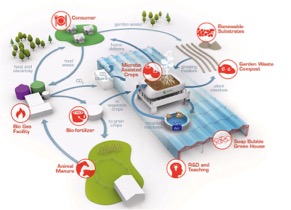MAJOR SOCIETAL CHALLENGE: FOOD AND ENERGY PRODUCTION AND CLIMATE CHANGE
Currently, the agricultural sector is one of the largest contributors of climate gas emissions and a major cause of global warming. The sector contributes directly to greenhouse gas emissions through use of fossil fuel and production of crop and livestock. In a changing climate, “indoor farming” can be an efficient and sustainable way to increase food production in urban areas, while reducing pressure on natural ecosystems. However, to reduce the negative impact from cultivation in greenhouses, we need to transform the sector to become a solution rather than the cause of climate change.

THE MAGIC FACTORY: A COMMOND CASE FOR THE LOOP PROPOSAL
In parallel with our initiative, an infrastructure is established in Tønsberg (south of Oslo; see figure above) that is an international pioneer in integrating food and energy production with waste treatment. The concept is to recycle food waste and manure from local farms into environmentally friendly biogas and valuable organic fertilizer for the production of new food and thereby creating a food-waste-food circular economy. The food waste is partly gained from residents of eastern Norway, from Kragerø to Asker, while manure comes from agriculture in Vestfold. Yearly the plant receives 60,000 tonnes of food waste and manure, which allows biogas production equivalent to 6.8 million liters of diesel. The fuel will be used by 80% of buses in Vestfold. CO2 from the biogas production will be organically captured by production of crops in a customized greenhouse for food production, together with organic fertilizer (i.e. digestate) residual material from a biogas plant. Greenhouses are currently being established for local food production. The plant contributes to significantly reducing greenhouse gas emissions, green growth and value creation in the region. This semi-closed greenhouse is a key to fully integrate all components of waste, energy production and materials. This is a major reason why the infrastructure has a status as a National Pilot and why Innovation Norway has recently financially supported the first greenhouses. However, despite the good prospects, the Magic Factory need to be opened up towards cross-disciplinary competence to address challenges and possibly enable robust and functional gas and food production and in line with societal concerns.
A CROSS-DISCIPLINARY RESEARCH GROUP
Questions and solutions related to technology, innovation and practice are in general complex, controversial and geographically differentiated. Development of the future agriculture must therefore adopt skills, abilities and perspectives from different scientific approaches. In scientific context it involves the presence of various disciplines, which previously did not necessarily share language, concepts, or even a desire to work together. We want to integrate and synthesize perspectives from different disciplines to achieve a better and more comprehensive understanding of the food-energy loop so that solutions are sustainable in the long-term perspective. We will: a) Address problems that are user-inspired and context driven, b) embrace complexity, c) recognize and incorporate multi stakeholders perspectives and values, and d) use these cross-disciplinary approaches to complement, and not replace, disciplinary research perspectives.
But the creation of multidisciplinary teams is not an easy task. Often the result can be a form of cosmetic cross-disciplinarity where the relationship between the disciplines continues to be superficial. We have therefore established a team of researchers from social and life sciences at UiO who have long experience in cross-disciplinary communication and research. In addition, the team includes the inventors of the Magic Factory and in the forefront of the development of this facility.